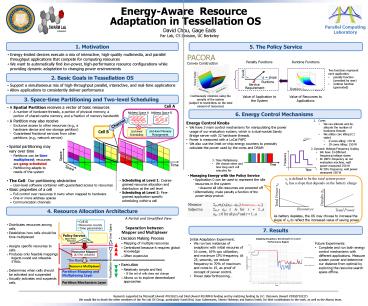Resource Management in Tessellation OS - PowerPoint PPT Presentation
1 / 1
Title:
Resource Management in Tessellation OS
Description:
Energy-Aware Resource Adaptation in Tessellation OS Parallel Computing Laboratory David Chou, Gage Eads Par Lab, CS Division, UC Berkeley 1. Motivation – PowerPoint PPT presentation
Number of Views:76
Avg rating:3.0/5.0
Title: Resource Management in Tessellation OS
1
Energy-Aware Resource Adaptation in
Tessellation OS
Parallel Computing Laboratory
David Chou, Gage Eads Par Lab, CS Division, UC
Berkeley
1. Motivation
5. The Policy Service
- Energy-limited devices execute a mix of
interactive, high-quality multimedia, and
parallel throughput applications that compete for
computing resources - We want to automatically find low-power,
high-performance resource configurations while
providing dynamic adaptation to changing power
environments
PACORA
Penalty Functions Value of Application to the
System
Runtime Functions Value of Resources to
Applications
Convex Construction
- Two functions represent each application
- penalty function (provided by user)
- runtime function (generated)
2. Basic Goals in Tessellation OS
- Support a simultaneous mix of high-throughput
parallel, interactive, and real-time applications - Allow applications to consistently deliver
performance
Runtime1((0,1), , (n-1,1))
Continuously minimize using the penalty of the
system (subject to restrictions on the total
amount of resources)
3. Space-time Partitioning and Two-level
Scheduling
- A Spatial Partition receives a vector of basic
resources - A number of hardware threads, a portion of
physical memory, a portion of shared cache
memory, and a fraction of memory bandwidth
6. Energy Control Mechanisms
- A Partition may also receive
- Exclusive access to other resources (e.g., a
hardware device and raw storage partition) - Guaranteed fractional services from other
partitions (e.g., network service)
- Cores
- We can allocate and de-allocate the number of
hardware threads - We utilize core idling (C1 state)
- 0 cores idling 170 W
- 29 cores idling 150 W
- Energy Control Knobs
- We have 3 main control mechanisms for
manipulating the power usage of our evaluation
system, which is a dual-socket Sandy Bridge
server with 32 hardware threads. - Power is measured with a LoCal FitPC
- We also use the Intel on-chip energy counters to
precisely calculate the power used by the cores
and DRAM
- Spatial partitioning may vary over time
- Partitions can be time multiplexed resources are
gang-scheduled - Partitioning adapts to needs of the system
- 2. Dynamic Voltage/Frequency Scaling
- We have 14 different frequency/voltage states
- At 100 frequency on our evaluation machine, wall
power measured 250 W - At 50 frequency, wall power measured 150 W
- 3. Time Multiplexing
- We choose when and how long each cell executes for
- Managing Energy with the Policy Service
- Application 0 can be used to represent the idle
resources in the system - Assume all idle resources are powered off
- Alternatively, make penalty a function of the
power-delay product
?0 is defined to be the total system power ?0 has
a slope that depends on the battery charge
- Scheduling at Level 1 Coarse-grained resource
allocation and distribution at the cell level - Scheduling at Level 2 Fine-grained
application-specific scheduling within a cell
- The Cell Our partitioning abstraction
- User-level software container with guaranteed
access to resources - Basic properties of a cell
- Full control over resources it owns when mapped
to hardware - One or more address spaces
- Communication channels
4. Resource Allocation Architecture
A Partial and Simplified View
- Cell ID
- Resource counts
- Time parameters
- Distributes resources among cells
- Establishes how cells should be time multiplexed
7. Results
Separation between Mapper and Multiplexer
User Space
Policy Service
- Decision Making Process
- Mapping of multiple resources
- Centralized because it requires global knowledge
- Often expensive
- Initial Adaptation Experiment
- We run two instances of swaptions with initial
resoures of 16 cores, 16 cpu utilization, and
maximum CPU frequency. At 25, seconds, we reduce
frequency to 70 of maximum and cores to 15, as
proof of concept of power control. - Power data forthcoming
Space-Time Resource Graph
STRG
- Future Experiments
- Complete and run both energy control mechanisms
with different applications. Measure system power
and determine our distance from optimal by
exploring the resource search space offline.
- Assigns specific resources to cells
- Produces only feasible mappings
- Rejects invalid and infeasible STRGs
Partition Mapping and Multiplexing Layer
Resource Mapper ( STRG Validator)
The Plan
- Execution
- Relatively simple and fast
- If the set of cells does not change
- Allows us to explore decentralized approaches
Tessellation Kernel
Resource Multiplexer
- Determines when cells should be activated and
suspended - Actually activates and suspends cells
Partition Mechanism Layer
Research supported by Microsoft (Award 024263)
and Intel (Award 024894) funding and by matching
funding by U.C. Discovery (Award DIG0710227) We
would like to thank the other members of the Par
Lab OS Group, particularly Sarah Bird, Juan
Colmenares, Steven Hofmeyr, and Burton Smith, for
their contributions to the work, as well as the
Akaros team.































